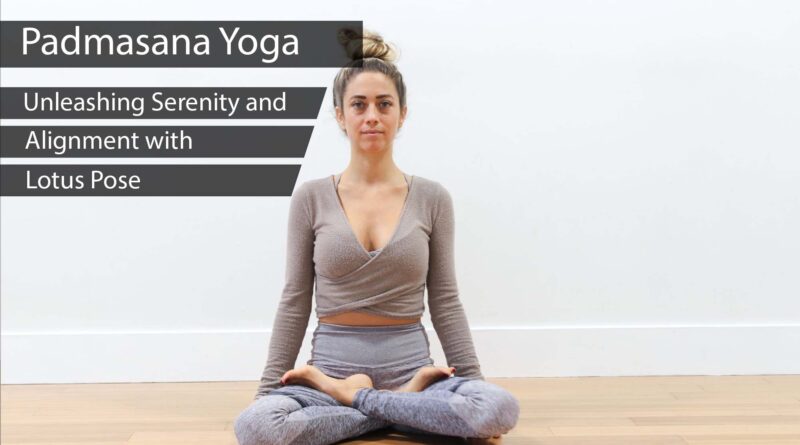Padmasana Yoga: Unleashing Serenity and Alignment with Lotus Pose
Table of Contents
Introduction
Padmasana Yoga, commonly known as Lotus Pose, is a revered yoga posture that symbolizes purity, enlightenment, and spiritual awakening. Derived from the Sanskrit words “padma” (meaning lotus) and “asana” (meaning pose), Padmasana is a meditative posture that cultivates stillness, inner harmony, and a deep connection with the self.
In this article, we will explore the steps, benefits, variations, and precautions associated with Padmasana, empowering you to embrace this transformative pose for your overall well-being.
How to Perform Padmasana Yoga
To practice Padmasana Yoga, follow these step-by-step instructions:
Step 1: Find a quiet and comfortable space to sit, preferably on a yoga mat or cushion.
Step 2: Sit with your legs extended in front of you, spine erect, and shoulders relaxed.
Step 3: Bend your right knee and bring your right foot onto your left thigh, ensuring that the sole faces upward and the heel is close to your abdomen.
Step 4: Similarly, bend your left knee and bring your left foot onto your right thigh, positioning the sole upward and the heel near your abdomen.
Step 5: Rest your hands on your knees, palms facing upward, or adopt a mudra of your choice, such as Chin Mudra or Gyan Mudra.
Step 6: Close your eyes, relax your facial muscles, and focus on your breath.
Step 7: Hold the pose for a comfortable duration, gradually extending the duration as you progress in your practice.
Benefits of Padmasana Yoga
Regular practice of Padmasana Yoga can offer a myriad of benefits, including:
a. Enhanced Meditation and Concentration: Padmasana provides a stable and comfortable base for deepening meditation practices, fostering concentration, and promoting mental clarity.
b. Improved Posture and Spinal Alignment: Sitting in Padmasana encourages an upright spine, strengthens the core muscles, and promotes good posture, reducing the risk of back and neck pain.
c. Calms the Mind and Reduces Stress: The grounded and centered nature of Padmasana helps calm the mind, alleviate anxiety, stress, and promote a sense of inner tranquility.
d. Opens the Hips and Increases Flexibility: The pose stretches and opens the hips, groin, and inner thighs, promoting flexibility and relieving tension in these areas.
e. Stimulates Energy Flow: Padmasana Yoga facilitates the flow of energy through the body, activating the energy centers (chakras) and promoting balance and harmony.
f. Enhances Digestion and Assimilation: The gentle compression on the lower abdomen in Padmasana stimulates digestion, improves metabolism, and enhances the assimilation of nutrients.

Variations of Padmasana Yoga
While Padmasana is a complete pose in itself, here are a few variations that you can explore:
a. Half Lotus Pose (Ardha Padmasana): If the full Lotus Pose is challenging, you can practice Ardha Padmasana by placing one foot on the opposite thigh while keeping the other foot on the ground.
b. Easy Pose (Sukhasana): For those with tight hips or discomfort in the knees, Sukhasana provides a comfortable alternative. Simply cross your legs and rest your hands on your knees.
c. Supported Lotus Pose: If you require additional support, you can sit on a cushion or bolster to elevate your hips and ease any strain on your knees or hips.
Precautions and Contraindications
While Padmasana Yoga is generally safe for most practitioners, it’s important to consider the following precautions:
a. Avoid practicing Padmasana if you have knee or ankle injuries or experience discomfort in the pose. Modify the posture or seek guidance from a qualified yoga instructor.
b. If you have a recent or chronic injury to the hips, knees, or ankles, it is advisable to avoid Padmasana or seek guidance from a healthcare professional or experienced yoga teacher.
c. Always listen to your body and respect its limits. Do not force yourself into the pose and avoid any pain or excessive strain.
Conclusion
Padmasana, the Lotus Pose, invites you to embrace serenity, alignment, and self-discovery on your yoga journey. By practicing this meditative posture regularly, you can experience enhanced concentration, improved posture, and a calm mind.
Remember to approach Padmasana with patience, respect your body’s capabilities, and allow the lotus within you to bloom as you embark on a transformative path of self-realization and inner peace.





